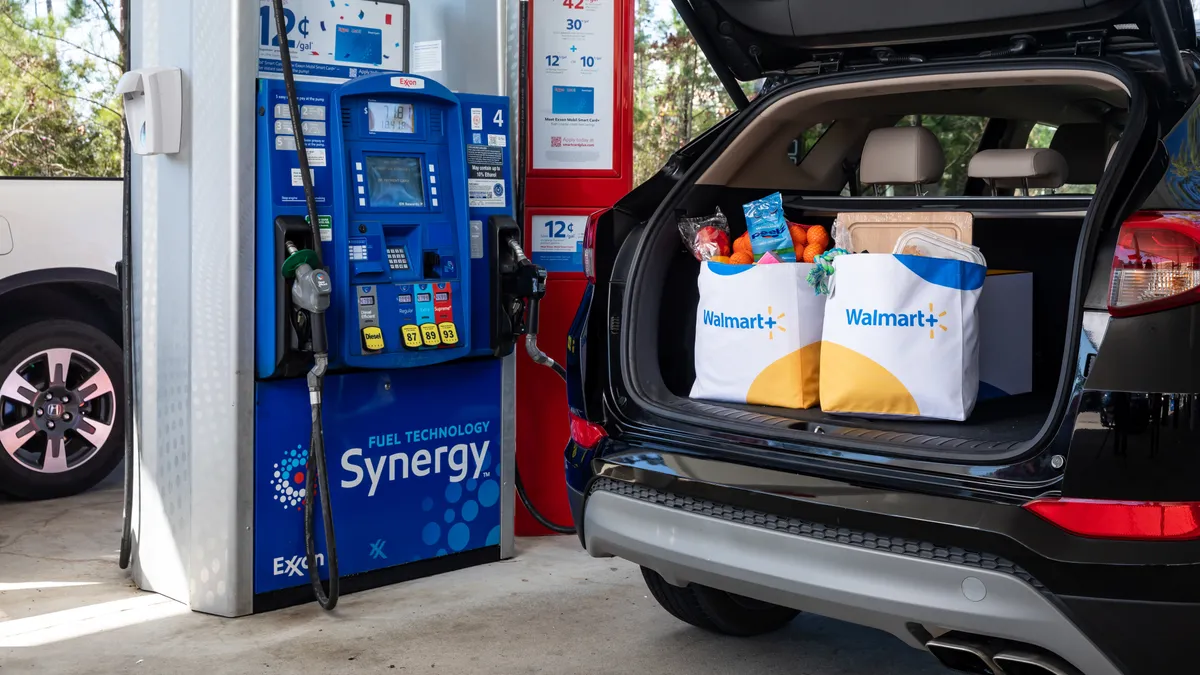Dive Brief:
- Walmart accounted for nearly 36% of all U.S. online grocery sales in the second quarter — achieving a new record high for the retailer that’s up 5 percentage points from its share a year prior, according to a new report produced by Brick Meets Click and sponsored by Mercatus.
- Walmart’s Q2 grocery e-commerce sales marked the third consecutive quarter that the retailer has surpassed supermarkets’ share.
- “The combined effect of price inflation and the expiration of COVID financial supports has triggered a flight-to-value as purchasing power remains under pressure,” Brick Meets Click Partner David Bishop said in a statement.
Dive Insight:
Walmart has eclipsed supermarkets’ 1.5% share edge in Q2 of 2022, with the retailer ending Q2 of this year with a 5.7% share advantage, the report noted.
Brick Meets Click and Mercatus said that Walmart’s fortification of its role as a top grocery e-commerce market leader over the past year follows the peak of food-at-home inflation in the third quarter of last year. Grocery inflation hit a record high with its annual rate of 13.5% last August.
While the grocery inflation rate has slowly but steadily deflated since then, consumers have remained sensitive to food prices. Brick Meets Click said that its own analysis of CPI data found that U.S. households’ purchasing power slipped over 7% during the first half of 2023 compared to a year ago. During the same period in 2022, it declined more than 9% compared to a year ago. Prior to the pandemic, purchasing power was less volatile, dipping 0.5% and 1% during the first half of 2018 and 2019, respectively, the firm noted.
Target, meanwhile, has maintained its own moderate grocery e-commerce growth during the last two years, ending the second quarter with roughly 7% of total online grocery sales, the report said. Target’s “strong and consistent execution,” especially with pickup orders, and a price gap that is halfway between supermarkets and Walmart have likely bolstered the retailer’s online grocery business, per the report.
Along with Walmart’s growing grocery e-commerce share, the report found another worrying statistic for grocers: The gap in repeat intent rates is widening between mass merchants and supermarkets in both the pickup and delivery channels.
Pickup, though, could be a bright spot for supermarkets.
Pickup has been steadily expanding its share of grocery e-commerce sales, with Brick Meets Click and Mercatus noting that the channel is a lower-cost service compared to delivery. The channel accounted for nearly 48% of U.S. grocery e-commerce sales at the end of Q2, with both supermarkets and mass retailers contributing to its share growth as they roll out the option to more stores, the report said.
Pickup’s share recorded a 1.9% jump in Q2 of this year compared to the same period in 2022, during which its share increased 0.8% year-over-year, per the report.
As traditional grocers look to take on the growing competition posed by mass retailers, the report says savings, personalization and pickup can be key areas to focus on.
Mercatus President and CEO Sylvain Perrier said that grocers can also look to provide and expand their pickup services to grow their grocery e-commerce presence.
“As competition for the shopper intensifies, regional grocers should be leveraging analytics and insights to provide customers with personalized recommendations, discounts, and offers as well as developing targeted, cost-effective strategies to encourage and reward repeat purchases online and in-store,” Perrier said in a statement.
Bishop said that it’s “vital” for grocers to offer consumers more ways to save money while also offering an online experience that meets their expectations.
The report is based on an analysis of data from the monthly Brick Meets Click/Mercatus Grocery Shopping Survey, including 21,799 survey responses compiled during 2021, 20,948 responses during 2022 and 11,001 responses over the first six months of 2023.














